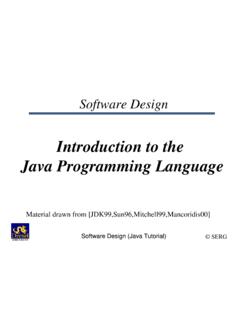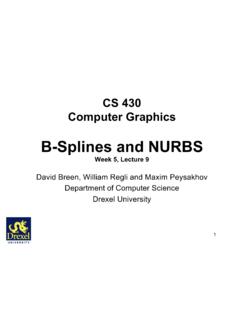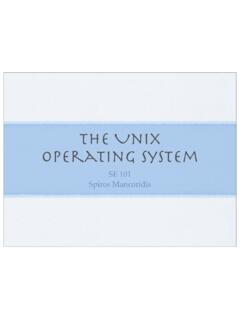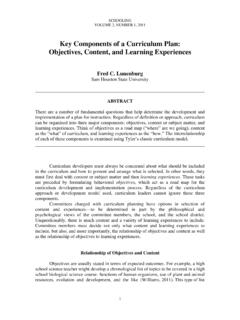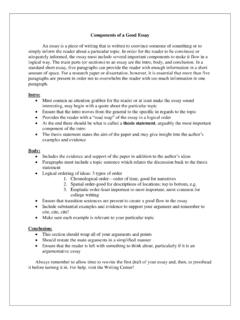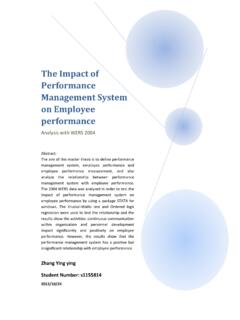Transcription of The Mythical Man-Month - College of Computing & Informatics
1 2 The Mythical Man-Month2 The Mythical Man-MonthGood cooking fakes time. If you are made to wait, it is toserve you better, and to please OF RESTAURANT ANTOINE. NEW ORLEANS1314 The Mythical Man-MonthMore software projects have gone awry for lack of calendar timethan for all other causes combined. Why is this cause of disasterso common?First, our techniques of estimating are poorly developed. Moreseriously, they reflect an unvoiced assumption which is quite un-true, , that all will go , our estimating techniques fallaciously confuse effortwith progress, hiding the assumption that men and months , because we are uncertain of our estimates, softwaremanagers often lack the courteous stubbornness of Antoine's , schedule progress is poorly monitored. Techniquesproven and routine in other engineering disciplines are consideredradical innovations in software , when schedule slippage is recognized, the natural (andtraditional) response is to add manpower.
2 Like dousing a fire withgasoline, this makes matters worse, much worse. More fire re-quires more gasoline, and thus begins a regenerative cycle whichends in monitoring will be the subject of a separate us consider other aspects of the problem in more programmers are optimists. Perhaps this modern sorcery espe-cially attracts those who believe in happy endings and fairy god-mothers. Perhaps the hundreds of nitty frustrations drive away allbut those who habitually focus on the end goal. Perhaps it ismerely that computers are young, programmers are younger, andthe young are always optimists. But however the selection processworks, the result is indisputable: "This time it will surely run," or"I just found the last bug."So the first false assumption that underlies the scheduling ofsystems programming is that all will go well, , that each task willhike only as long as it "ought" to 15 The pervasiveness of optimism among programmers deservesmore than a flip analysis.
3 Dorothy Sayers, in her excellent book,The Mind of the Maker, divides creative activity into three stages:the idea, the implementation, and the interaction. A book, then,or a computer, or a program comes into existence first as an idealconstruct, built outside time and space, but complete in the mindof the author. It is realized in time and space, by pen, ink, andpaper, or by wire, silicon, and ferrite. The creation is completewhen someone reads the book, uses the computer, or runs theprogram, thereby interacting with the mind of the description, which Miss Sayers uses to illuminate notonly human creative activity but also the Christian doctrine of theTrinity, will help us in our present task. For the human makers ofthings, the incompletenesses and inconsistencies of our ideasbecome clear only during implementation. Thus it is that writing,experimentation, "working out" are essential disciplines for many creative activities the medium of execution is intract-able.
4 Lumber splits; paints smear; electrical circuits ring. Thesephysical limitations of the medium constrain the ideas that maybe expressed, and they also create unexpected difficulties in , then, takes time and sweat both because ofthe physical media and because of the inadequacies of the under-lying ideas. We tend to blame the physical media for most of ourimplementation difficulties; for the media are not "ours" in theway the ideas are, and our pride colors our programming, however, creates with an exceed-ingly tractable medium. The programmer builds from purethought-stuff: concepts and very flexible representations the medium is tractable, we expect few difficulties inimplementation; hence our pervasive optimism. Because our ideasare faulty, we have bugs; hence our optimism is a single task, the assumption that all will go well has aprobabilistic effect on the schedule. It might indeed go as16 The Mythical Man-Monthfor there is a probability distribution for the delay that will beencountered, and "no delay" has a finite probability.
5 A large pro-gramming effort, however, consists of many tasks, some chainedend-to-end. The probability that each will go well becomes van-ishingly 'Man-MonthThe second fallacious thought mode is expressed in the very unitof effort used in estimating and scheduling: the Man-Month . Costdoes indeed vary as the product of the number of men and thenumber of months. Progress does not. Hence the Man-Month as a unitfor measuring the size of a job is a dangerous and deceptive myth. Itimplies that men and months are and months are interchangeable commodities only whena task can be partitioned among many workers with no communica-tion among them (Fig. ). This is true of reaping wheat or pickingcotton; it is not even approximately true of systems Time versus number of workers perfectly partitionable taskThe Man-Month 17 When a task cannot be partitioned because of sequential con-straints, the application of more effort has no effect on the sched-ule (Fig.)
6 The bearing of a child takes nine months, no matterhow many women are assigned. Many software tasks have thischaracteristic because of the sequential nature of Time versus number of workers unpartitionable taskIn tasks that can be partitioned but which require communica-tion among the subtasks, the effort of communication must beadded to the amount of work to be done. Therefore the best thatcan be done is somewhat poorer than an even trade of men formonths (Fig. ).18 The Mythical Man-MonthMenFig. Time versus number of workers partitionable task requiringcommunicationThe added burden of communication is made up of two parts,training and intercommunication. Each worker must be trained inthe technology, the goals of the effort, the overall strategy, and theplan of work. This training cannot be partitioned, so this part ofthe added effort varies linearly with the number of is worse. If each part of the task must beseparately coordinated with each other part/ the effort increases asn(n-I)/2.
7 Three workers require three times as much pairwiseintercommunication as two; four require six times as much as , moreover, there need to be conferences among three, four, etc.,workers to resolve things jointly, matters get worse yet. The addedeffort of communicating may fully counteract the division of theoriginal task and bring us to the situation of Fig. Test 19 MenFig. Time versus number of workers task with complex interrela-tionshipsSince software construction is inherently a systems effort anexercise in complex interrelationships communication effort isgreat, and it quickly dominates the decrease in individual task timebrought about by partitioning. Adding more men then lengthens,not shortens, the TestNo parts of the schedule are so thoroughly affected by sequentialconstraints as component debugging and system test. Further-more, the time required depends on the number and subtlety ofthe errors encountered. Theoretically this number should be of optimism, we usually expect the number of bugs to be20 The Mythical Man-Monthsmaller than it turns out to be.
8 Therefore testing is usually themost mis-scheduled part of some years I have been successfully using the followingrule of thumb for scheduling a software task:l/3 planningl/6 codingl/4 component test and early system testl/4 system test, all components in differs from conventional scheduling in several importantways:1. The fraction devoted to planning is larger than normal. Evenso, it is barely enough to produce a detailed and solid specifi-cation, and not enough to include research or exploration oftotally new The half of the schedule devoted to debugging of completedcode is much larger than The part that is easy to estimate, , coding, is given onlyone-sixth of the examining conventionally scheduled projects, I have foundthat few allowed one-half of the projected schedule for testing,but that most did indeed spend half of the actual schedule for thatpurpose. Many of these were on schedule until and except insystem to allow enough time for system test, in particular, ispeculiarly disastrous.
9 Since the delay comes at the end of theschedule, no one is aware of schedule trouble until almost thedelivery date. Bad news, late and without warning, is unsettlingto customers and to , delay at this point has unusually severe finan-cial, as well as psychological, repercussions. The project is fullystaffed, and cost-per-day is maximum. More seriously, the soft-ware is to support other business effort (shipping of computers,operation of new facilities, etc.) and the secondary costs of delay-ing these are very high, for it is almost time for software Schedule Disaster 21 Indeed, these secondary costs may far outweigh all others. It istherefore very important to allow enough system test time in theoriginal EstimatingObserve that for the programmer, as for the chef, the urgency ofthe patron may govern the scheduled completion of the task, butit cannot govern the actual completion. An omelette, promised intwo minutes, may appear to be progressing nicely.
10 But when it hasnot set in two minutes, the customer has two choices wait or eatit raw. Software customers have had the same cook has another choice; he can turn up the heat. Theresult is often an omelette nothing can save burned in one part,raw in I do not think software managers have less inherentcourage and firmness than chefs, nor than other engineering man-agers. But false scheduling to match the patron's desired date ismuch more common in our discipline than elsewhere in engineer-ing. It is very difficult to make a vigorous, plausible, and job-risking defense of an estimate that is derived by no quantitativemethod, supported by little data, and certified chiefly by thehunches of the two solutions are needed. We need to develop andpublicize productivity figures, bug-incidence figures, estimatingrules, and so on. The whole prof ession can only profit from sharingsuch estimating is on a sounder basis, individual managerswill need to stiffen their backbones and defend their estimateswith the assurance that their poor hunches are better than wish-derived Schedule DisasterWhat does one do when an essential software project is behindschedule?

